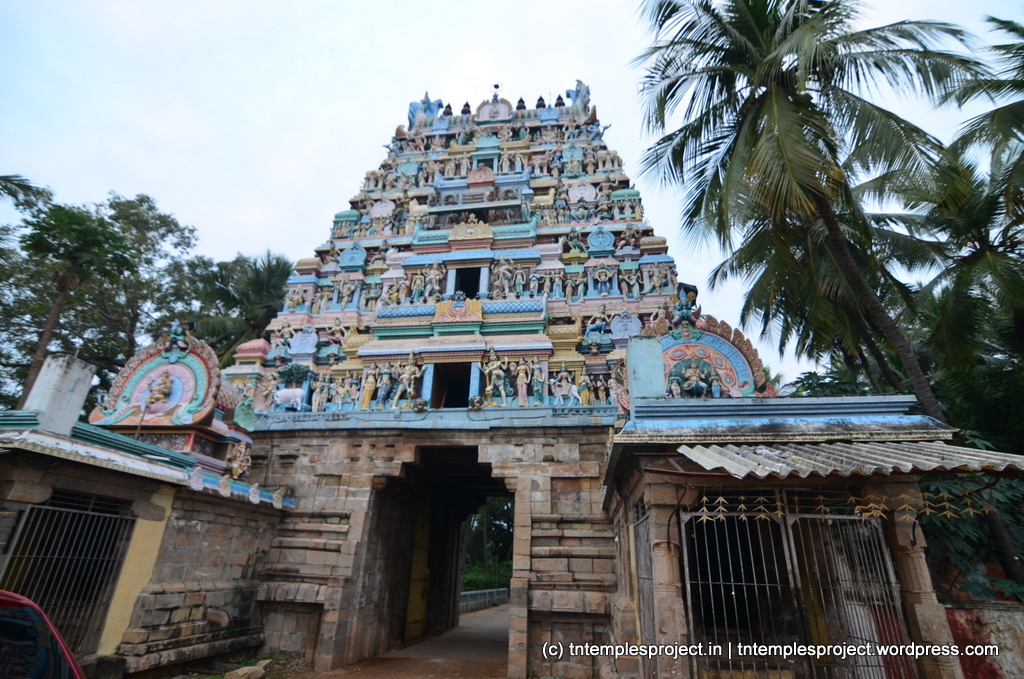Basic information about the temple
| Moolavar: | Gomukteeswarar | Ambal / Thayar: | Athulya Gujambikai, Oppillamulai Nayaki |
| Deity: | Siva | Historical name: | Tiruvaaduthurai, Nandi Nagaram, Navakoti Chitrapuram |
| Vriksham: | Arasamaram | Teertham: | Gomukthi Teertham, Padma Teertham, Kaivalya Teertham |
| Agamam: | Age (years): | Timing: | 6 to 12 & 4 to 8 | Parikaram: |
| Temple group: | Paadal Petra Sthalam (Kaveri Then Karai) | – | |
| Sung by: | Temple set: | ||
| Navagraham: | Nakshatram: | ||
| City / town: | Tiruvavaduthurai | District: | Thanjavur |
| Maps from (click): | Current location | Mayiladuthurai (17 km) | Kumbakonam (22 km) |
| Tiruvarur (39 km) | Nagapattinam (58 km) |
Location
Sthala puranam and temple information
Siva and Parvati were playing a game of Chokkattan, and Siva was winning. Parvati was annoyed at this, and wanted to quit, which upset the Lord. So he cursed her to be born on earth, as a cow. Parvati pleaded with Him, and so to mitigate the curse, He advised her to take the form of a cow, at Tiruvavaduthurai, and that He would come to redeem her. Parvati did so, and in the course of time, Siva redeemed Her by marrying Her on earth, and so getting the name Gomukteswarar (go=cow in Sanskrit).
This is the first temple in the series of temples near Kumbakonam associated with Siva’s marriage to Parvati, as the Goddess was born here as a cow. She then ended up going to Tirukozhumbiam, and grazing on her own at Therazhundur, until Vishnu (Her brother) in the form of a cowhered took her back to Tiruvavaduthurai, where she gained the form of a young girl, and was brought up as the daughter of Bharata maharishi, at Tiruturutti (Kuttalam). Later, Siva met Her at Ethirkolpadi (Mela Tirumanancheri), the pre-nuptial yagams were conducted at Velvikudi (velvi = rituals), and the marriage itself took place at Tirumanancheri. Read about this in detail here.

Sage Sundranathar once came to the earth from Kailasam. He was wandering around when he saw a cowherd called Moolan lying dead, and his cattle surrounded him, crying. Taking pity on the animals, the sage transformed himself into Moolan, hid the real Moolan’s corpse, and took the cattle home. After this, the sage tried to locate the corpse, but it had been cremated by then. So the sage decided to live life as Moolan, refusing to stay with Moolan’s wife but staying at the temple instead. Over time, his devotion to Lord Siva led him to compose the Tirumandiram of 3000 verses – singing one verse a year for 3000 years – and he himself came to be known as Tirumoolar. The Tirumandiram is the 10th volume of the Tirumurai. Tirumoolar founded the Tiruvavaduthurai Adheenam, which is located within this temple’s premises. Over time, Tirumoolar merged with the Lord here. In the outer prakaram, there is a separate shrine for Tirumoolar.

Tirumaaliga Thevar, a disciple of Bhoga Siddhar, stayed here serving the Lord and His devotees. He lived in the place that is today the Tiruvavaduthurai Adheenam. Based on wrong information, the King believed that Tirumaaliga Thevar was undertaking subversive activities, and sent his army to eliminate him. The Goddess requested the Lord to save Tirumaaliga Thevar, and Siva deputed Nandi’s army for this. They defeated the king’s army, and the Nandis all joined together to become one huge Nandi which is at the entrance of the temple. This temple is considered the Nandi kshetram, to the Tiruvidaimaruthur Mahalinga Swamy temple.
Sambandar‘s father, Sivapada Hrudayar, wanted to undertake a yagam, but did not have the money for it. So Sambandar sang a pathigam, and Siva sent his ganas with a basket full of gold, which they left at the bali peetham near the Nandi.
Sundarar prayed for regaining his eyesight at this temple. During Chola times, this temple complex has served as a medical facility / hospital, to treat the ill and aged. Muchukunda Chakravarti worshipped here to beget children. Lord Siva showed him this place in the same form as Tiruvarur, and Himself as Thyagarajar of Tiruvarur.

The utsava murtis at this temple are special. Called the Anainthu Irundha Nayakar, Lord Siva is seen embracing Parvati, but their hands do not touch. Couples worship here for marital unity. It is said when Parvati came to be born here, Vinayakar accompanied here. So he is known as Thunai Vanda Vinayakar. The sthala vriksham here – the Arasamaram – is said to represent the Devas, who are here perpetually. Yama worshiped Lord Siva here, and was given the privilege of taking the place of Rishabham here.
This temple is one of the Kanjanoor Sapta Sthanam temples. The Navakoti Siddhars including Bhoga Siddhar performed penance here and Lord Siva imparted to them, the ashtama siddhis (8 yogic powers). This temple is also referred to in the Tiruvisaippaa.
The inscriptions in the temple refer to Chola kings Parantaka Chola and Raja Raja Chola I. While much of the temple is of Chola architecture, various rulers have contributed to the construction and renovation of this temple. These include Kochchenga Cholan, Cheraman Peruman (Chera king and one of the 63 Nayanmars) and Vikrama Pandyan of the Pandya dynasty.
Other information for your visit
If time permits, it is worth visiting the Tiruvavaduthurai Adheenam located inside this temple’s premises. Also, the temples connected with Siva’s marriage to Parvati are all located close by, and can be covered in about 5-6 hours, starting with this temple.
Contact
Phone: 04363 232055
Gallery































